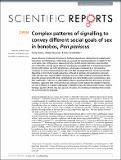Complex patterns of signalling to convey different social goals of sex in bonobos, Pan paniscus
Abstract
Sexual behaviour in bonobos (Pan paniscus) functions beyond mere reproduction to mediate social interactions and relationships. In this study, we assessed the signalling behaviour in relation to four social goals of sex in this species: appeasement after conflict, tension reduction, social bonding and reproduction. Overall, sexual behaviour was strongly decoupled from its ancestral reproductive function with habitual use in the social domain, which was accompanied by a corresponding complexity in communication behaviour. We found that signalling behaviour varied systematically depending on the initiator's goals and gender. Although all gestures and vocalisations were part of the species-typical communication repertoire, they were often combined and produced flexibly. Generally, gestures and multi-modal combinations were more flexibly used to communicate a goal than vocalisations. There was no clear relation between signalling behaviour and success of sexual initiations, suggesting that communication was primarily used to indicate the signaller's intention, and not to influence a recipient's willingness to interact sexually. We discuss these findings in light of the larger question of what may have caused, in humans, the evolutionary transition from primate-like communication to language.
Citation
Genty , E , Neumann , C & Zuberbuehler , K 2015 , ' Complex patterns of signalling to convey different social goals of sex in bonobos, Pan paniscus ' , Scientific Reports , vol. 5 , 16135 , pp. 1-13 . https://doi.org/10.1038/srep16135
Publication
Scientific Reports
Status
Peer reviewed
ISSN
2045-2322Type
Journal article
Description
This project has received funding from the European Union’s Seventh Framework Programme for research, technological development and demonstration under grant agreement no 283871.Collections
Items in the St Andrews Research Repository are protected by copyright, with all rights reserved, unless otherwise indicated.

